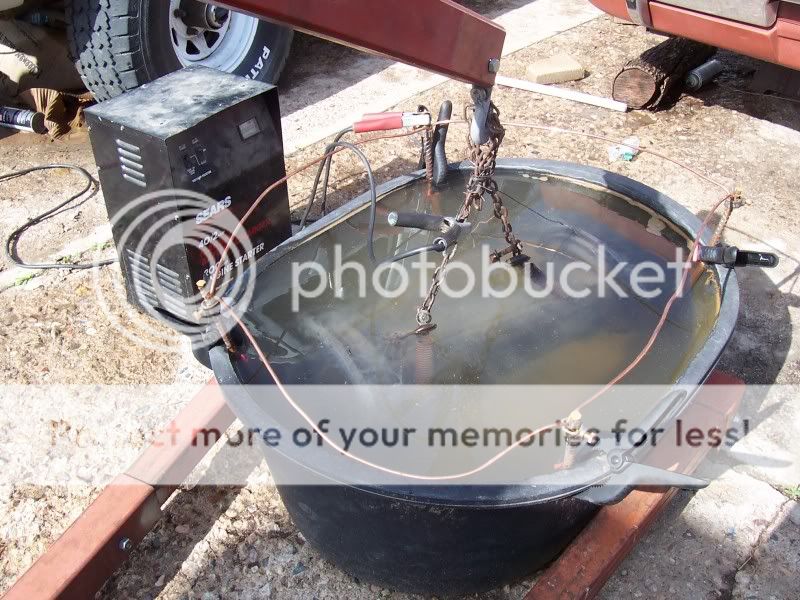Thanks, The Set Up: Using a plastic, or non-conductive bucket (not metal), mix a solution of 5 gallons water to 1/3 to 1/2 cup laundry soda. Mix well so all soda is dissolved. Do not try to use other salts. You won't get better results and dangerous effects may occur. Caustic soda, for example, is far too corrosive. Solutions of ordinary table salt can generate chlorine gas (toxic) at the positive electrode (anode).
Clean the electrodes so they aren't too rusty - especially at the top ends - they need to make good electrical contact with your wire or cable AND with the water. I take mine to a wire wheel and give them just a real quick going over. Place electrodes in bucket around sides, so the clean, rust free ends stick up above the bucket. Use clamps or some means to hold them in place around the perimeter of the inside of the bucket or container so that they cannot move freely or fall into center of bucket. The electrodes must not touch the part(s) to be cleaned, which will be suspended in center of bucket. I use small C clamps. Whatever you use, it shouldn't be copper, and will get a bit messy if it gets into your cleaning solution.
Tie the electrodes together with wire or cables. I use copper wire twisted around the top ends, and have used old jumper cables. All electrodes need to be tied together "electrically". This will become the "anode" grid. Since the cleaning process is somewhat "line of sight" it's best to surround the part to be cleaned to some extent with the electrodes.
Suspend part to be cleaned into bucket so it hangs in the middle, not touching bottom, and not touching electrodes. I place a piece of rebar across top of bucket (see photo below) and bolt a small piece of chain to my part to be cleaned, and clamp the chain on the rod so that the chain hangs from the rod, and suspends the part into solution below. The part to clean then becomes the "cathode".
Attach battery charger - place NEGATIVE LEAD (this is critical!!) on the piece that is to be cleaned. Attach POSITIVE, or RED lead of charger, to electrode "grid" formed when you placed electrodes, or rods, into bucket and tied them all together.
Make sure electrodes and part to be cleaned are not touching each other, then turn on charger. Within seconds, you should see a lot of tiny bubbles rising from the part suspended in the mixture. Do not do this inside, or in a closed area - those bubbles are the component parts of water - H2O - hydrogen and oxygen. Remember the Hindenburg? Well, actually that was caused in part by the explosive coating they painted on the skin of the craft, but the hydrogen will burn explosively so DO be careful!
See how the rust and bubbles are attracted to the electrodes in the photo below? You will need to clean them from time to time - they will get covered with gunk; in fact, after many uses, they will have eroded down and need to be replaced. That is why I use rebar - it's easy to get, cheap, and most of all - SAFE FOR YOU and your environment! You can pour the waste solution on the lawn and it won't hurt it. Do watch out for ornamental shrubs, which may not like iron rich soil, however. No use making your spouse mad!
How large an item can you clean? Well, it's up to your imagination, your budget - because it takes water, your time and wife's patience. Try this process on a very large scale using a tank made of plywood and lined with plastic, a DC welder for power supply and hundreds of gallons of water. You will need to use more electrodes with larger parts and a larger "tank".
Safety Precautions:
- Make sure no spills can get to the battery charger. (electrocution potential as with any electric appliance)
- The leads from the charger are relatively safe, but you may still get a bit of a shock if you put your hands in the solution or touch the electrodes while the charger is running.
- Turn off the current before making adjustments to the setup. Just as a "spark" can cause a charging battery to explode in your face, this process produces similar gases because this process splits water into hydrogen gas (at the negative electrode) and oxygen at the positive electrode).
- Hydrogen will burn explosively if ignited. All flames, cigarettes, torches, etc. must be removed from the area, and sparks caused by touching the leads together must be avoided. The work should be performed outside or in a well ventilated area to remove these gases safely.
- Washing soda solutions are alkaline and will irritate the skin and eyes. Use eye protection and gloves. Immediately wash off any solution spilled or splashed onto your body.



